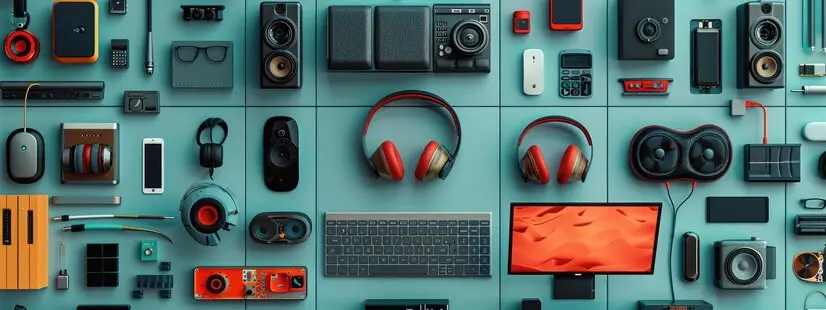The Rise of Smart Technology
The advent of smart technology has transformed the way people live and work, providing unprecedented convenience and efficiency through a variety of interconnected gadgets. Smart speakers, home automation systems, and smart appliances have become ubiquitous in the modern household, allowing users to streamline their domestic routines effortlessly. These devices are designed to enhance the quality of life by integrating into a connected ecosystem, which not only simplifies tasks but also optimizes energy consumption.
Smart speakers, such as those powered by voice assistants, have redefined the way we interact with our environment. They serve as central control hubs for other smart devices, enabling users to manage lighting, temperature, and security systems using voice commands. This level of automation fosters an intuitive user experience, making it easier for individuals to maintain their homes without the need for manual adjustments. Furthermore, smart speakers provide access to entertainment, information, and communication, showcasing the multifaceted role they play in contemporary households.
Another significant element of smart technology is the emergence of home automation systems. These systems allow for the integration of various smart devices, creating a seamless network that enhances overall living conditions. Homeowners can configure routines that cater to their preferences, such as setting lights to dim at a certain hour or adjusting thermostats based on occupancy. This intelligent energy management not only contributes to comfort but also has the potential to reduce utility costs, as devices can be programmed to operate efficiently.
Smart appliances further extend the benefits of smart technology, offering innovative features designed to simplify cooking, cleaning, and other household tasks. For instance, smart refrigerators can monitor food inventory and suggest recipes based on available ingredients, while washing machines can be programmed to run at off-peak energy hours. By embracing these advancements, individuals are not only optimizing their daily lives but also participating in a larger movement towards smarter living. As smart technology continues to evolve, its impact on domestic life will only become more profound.
Wearables: Redefining Health and Productivity
Wearable technology has emerged as a transformative force in our daily lives, particularly through devices such as fitness trackers, smartwatches, and health-monitoring gadgets. These devices not only assist in promoting a healthier lifestyle but also enhance productivity by seamlessly integrating fitness and health management with everyday tasks. Fitness trackers, for example, provide users with real-time data on physical activity, heart rate, and sleep patterns, enabling individuals to make informed decisions about their well-being.

The proliferation of smartwatches has further revolutionized the way we interact with technology. These multifunctional devices allow users to manage daily tasks, receive notifications, and communicate—all from their wrists. This level of connectivity fosters a more organized approach to daily living, thereby increasing overall productivity. According to a recent study, individuals using wearables reported a 20% increase in their physical activity levels, indicating a direct correlation between the use of these gadgets and improved health. Moreover, many wearables now integrate with smartphone applications, providing users with a comprehensive overview of their health metrics and task reminders, which enhance their ability to focus on priority tasks without being overwhelmed by information overload.
Real-life examples further illustrate the efficacy of wearables. For instance, employees at companies that promote the use of fitness trackers reported higher job satisfaction and engagement levels. Similarly, studies highlighted that teams using smartwatches to receive immediate notifications saw a 30% increase in project completion rates, demonstrating the potential of wearables to create a more efficient work environment. As such, wearable technology marks a significant advancement in both health management and productivity enhancement, adapting to the fast-paced demands of modern life while maintaining a focus on well-being.
Remote Work Revolution: Tools for Success
In recent years, the shift towards remote work has accelerated dramatically, necessitating the adoption of various gadgets engineered to optimize productivity and enhance the overall work-from-home experience. Essential tools such as high-definition webcams, noise-canceling headphones, and ergonomic office equipment have become critical for individuals striving for efficiency in their remote work environments.

High-quality webcams facilitate seamless communication during virtual meetings. They provide clear visuals, allowing team members to engage with each other more interactively. The importance of effective communication cannot be overstated, as it fosters collaboration and ensures that team dynamics are maintained, even when employees are not physically present in the same location. Additionally, many modern webcams come equipped with features like automatic framing and low-light correction, which further enhance video quality and contribute to a more professional presentation.
Moreover, noise-canceling headphones have emerged as indispensable gadgets for remote workers. They effectively minimize distractions from ambient noise, allowing individuals to focus on their tasks at hand. This is particularly vital in homes that may not be conducive to quiet work environments. By creating a more isolated auditory space, these headphones not only improve concentration but also mitigate stress levels associated with noisy backgrounds, ultimately enhancing the work experience.
Ergonomic office equipment, which includes adjustable desks and supportive chairs, plays a significant role in promoting physical well-being while working remotely. Prolonged periods of sitting can lead to discomfort and health issues; thus, investing in ergonomics is essential. Properly designed office furniture supports the body’s natural posture and reduces the likelihood of musculoskeletal problems, contributing to increased productivity over time.
In summary, the incorporation of these transformational gadgets into remote work routines addresses various challenges faced by telecommuters, ultimately enabling a seamless transition to a more effective and sustainable working environment.
Future Trends: Emerging Gadgets on the Horizon
The rapid advancement of technology continues to bring forth a plethora of innovative gadgets that promise to reshape our daily lives and work environments. Among the most influential trends are augmented reality (AR) and virtual reality (VR), which are increasingly gaining traction in both personal and professional spheres. These immersive technologies enable users to engage in enhanced interactions, whether through virtual meetings, immersive training programs, or interactive gaming experiences. As these tools become more sophisticated, we can anticipate a future where VR landscapes seamlessly blend with our physical world, resulting in unique collaborative workspaces and innovative educational platforms.
Another significant trend lies in the evolution of artificial intelligence (AI)-driven devices. These gadgets are designed to adapt to individual user preferences, making them invaluable for improving productivity and personal efficiency. AI-powered virtual assistants, for instance, can manage schedules, automate routine tasks, and provide personalized insights, ultimately fostering a smarter work environment. As these devices become more intuitive and capable of learning from user behavior, they will undoubtedly play a central role in streamlining our workflows and enhancing our decision-making processes.
Home robotics represent yet another frontier in the evolution of gadgets. As robot vacuum cleaners and smart kitchen appliances gain popularity, the integration of robotics into everyday tasks will likely become more prevalent. Future home robots could take on a range of responsibilities, from assisting with elderly care to managing complex home automation systems. These developments not only promise to improve convenience but also have the potential to significantly enhance the quality of life for various demographics.
In conclusion, the convergence of AR, VR, AI-driven tools, and home robotics heralds an exciting era where emerging gadgets are set to redefine our routines and work dynamics. As we embrace these technologies, they hold the potential to create more efficient, engaging, and personalized experiences in both personal and professional contexts.




